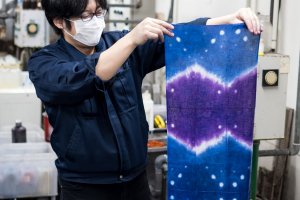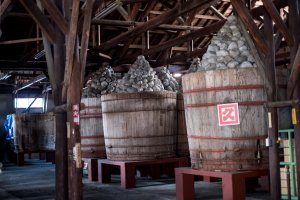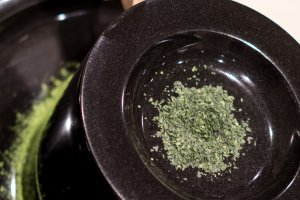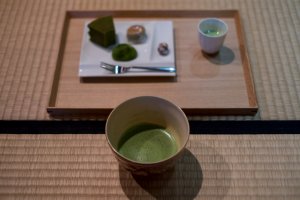Many visitors to Japan have spent some time in Aichi Prefecture without even knowing it. As the Nozomi bullet train whizzes by at 285 kilometers per hour (177 mph) from Tokyo to Kyoto, it makes a brief stop in Nagoya. Most people admire the cityscape from their seats, not realizing how important this region is to the development of Japan’s culinary history.
The Chita Peninsula—just south of the prefecture's capital city of Nagoya—is blessed with a mild climate and high quality water and so it has become a thriving brewing industry. Because of geographical factors, the region's shipping industry has developed for products to be sent to Tokyo, called Edo in the past. Merchants invested in infrastructure and ships necessary to get their products to a hungry nation. Aichi’s sake, mirin, soy sauce and miso have made their way to the homes of people in both Kanto in the east and Kansai in the west. Special vinegar made from local sake lees became a backbone of sushi rice in the streets of Edo. Hundreds of sake breweries flourished. A unique and flavorful food culture was born.
I spent three days exploring the origins of some of the region’s most famous ingredients. During this time, I picked up strong Hatcho miso from Okazaki, deep red vinegar from Handa, matcha tea from Nishio, and some local sake. The goal was to use these to make a fabulous lunch. I also tried my hands at making local crafts, namely tie-dyeing from Arimatsu and pottery from Seto.
With such a busy schedule picking up ingredients from the source, it was nice to be able to unwind at the end of the day, so I spent one night by the sea in a hot springs hotel and one night sipping craft coffee at a boutique hotel in Nagoya.
Day one: Arimatsu Shibori (tie-dyeing), Hatcho miso, Nishio matcha, and a stay in an oceanside hot spring.
Arimatsu
Arimatsu is only 20 minutes from Nagoya Station on the Meitetsu Line. Walking down the Edo-era (1603–1867) main road is like taking a trip back in time. Arimatsu was founded in 1608 as a town between two stops on the Old Tokaido Highway, a road connecting Edo and Kyoto. You can still get a sense of what it would feel like to be a traveler at that time. You are sure to notice the vivid blue noren curtains hanging in front of the old houses and warehouses. If you look closer, you’ll see intricate tie-dye patterns on the cloth. This is Arimatsu shibori, the town’s claim to fame. Over the years, local artisans developed more than 100 types of tie-dye techniques, called shibori. These range from simple designs like itajime shibori that can be folded and dyed in minutes to more complex ones like kumo shibori (kumo means spider, and the spider-web-like pattern is the reason for its name) that can take half a year for a single kimono. Arimatsu shibori was often purchased as presents for travelers on the highway along their journey.
For my homemade lunch, I’d need a placemat. Hiroaki Kuno is the 5th generation of tie-dye masters at Shibori-Dyeing Kuno-Studio. He works with his father, Tsuyoshi Kuno, making textile art from simple tenugui towels to yukata (kimono worn during summer). After explaining the history of the craft, he showed me to his workshop to try my hand at a couple of projects. By the time we finished, I had a gorgeous tenugui towel and two placemats in my favorite colors.
Hatcho miso
Miso is a fermented food made from two basic ingredients: soybeans and salt. It is an essential part of Japanese food culture, with many families enjoying miso soup daily. Many kinds of miso exist in Japan depending on the region. Miso's fermentation and aging process involves a multitude of factors, the slightest variation of which can result in vastly different tastes, colors, and textures. In modern times, most store-bought miso is made in industrial factories and for sale on the shelves in as short a time as possible. This is not the case at Hatcho miso, Aichi’s signature miso.
The Hatcho district from which this miso takes its name is just half a mile from Okazaki Park—the site of the castle where Tokugawa Ieyasu, the founder of the last shogunate in Japan, was born. Firmly textured, robust, all-natural, and laden with protein and earthy umami, this immune-boosting and cholesterol-lowering ingredient is made the traditional way today by two Okazaki brewers, Kakukyu and Maruya.
I joined a tour of the factory at Kakukyu Hatcho Miso to see firsthand how it was made both in the past and the present. Kakukyu has produced Hatcho miso since 1645 without altering the unique production method, which employs the basic ingredients of soybeans and salt, thus making it stand out from other types of miso. They still pile stones by hand on the huge six-ton barrels. Once conditions are right, huge stones are piled on top and the miso is left to ferment for two years. The result is a deep, in-your-face flavor that works very well with grilled and fried food.
Next door to the factory is a restaurant called Okazaki Kakukyu Hatcho Mura where you can try one of Aichi’s famous local foods: miso nikomi udon. While most udon dishes around Japan use a light dashi soup, miso nikomi udon has heavy miso flavors and is served in a hot clay pot.
For my homemade lunch, I picked up enough miso from the gift shop to make miso-katsu (deep-fried pork cutlet with miso sauce), another one of Aichi’s famous local dishes.
Nishio matcha
Stone-ground green tea powder, called matcha, is whisked to a velvety froth and served at formal tea ceremonies. It has become a worldwide hit. There are many ways to enjoy it, from making it into a sweet dessert to blending it with hot milk to make a matcha latte. When you think of matcha green tea, you probably think of Kyoto or Shizuoka. Enter Nishio, in the south of Aichi Prefecture. This region produces some of Japan’s most sought-after matcha. Leaves used in the production of matcha are grown under shade coverings to avoid astringent flavors before being harvested, steamed, dried, and ground into powder.
The Matcha Museum at Saijoen (Matcha Museum WakuWaku) is the perfect place to experience matcha. We learned the process from plant to cup, finally making our own original tea blend for a tea ceremony in an authentic Japanese tea room, called a chashitsu.
I picked up a small tin of premium matcha to make dessert for my lunch later on.
Minami Chita Onsen
The southern tip of the Chita Peninsula feels like the opposite of busy Nagoya City. Fishing boats head out into the Ise Bay for their daily catch on the calm waters and the sun sets over the mountains of Mie Prefecture in the distance. All of this can be seen from the rooftop, open-air hot spring at Genji Koh, a local ryokan (Japanese-style inn).

Though you may feel like sleeping in after the feast of local seafood, an early sunrise from the hot spring is a wonderful way to start the day.
Day two: Vinegar, sake, and Seto Pottery Town
Mizkan Vinegar
If you’ve ever eaten sushi, you know how important vinegar is to Japanese food. In 1804, an Aichi local from Handa, named Matazaemon I, visited Edo and ate sushi for the first time. He realized that he could make a suitable vinegar out of a byproduct of local sake production. Sake lees, called sake kasu, from nearby sake breweries could be aged and pressed into a rich vinegar. With Handa being a major shipping hub, his idea of supplying the nation with vinegar was born.
MIZKAN MUSEUM feels more like an art installation than a normal museum. Digital art is displayed over a full-size replica benzaisen sailing ship, the kind used in Edo times to bring vinegar from Aichi to Edo. A short, emotional film shows Mizkan’s commitment to healthful food for families. An entire exhibit about sushi explains the detailed history of sushi in Japan and abroad.
I picked up some bottles of Ajipon, one of Mizkan’s best-selling ponzu sauces, and branded it with my own photo. I also picked up a bottle of their Yamabuki vinegar for my upcoming lunch.
Kunizakari Sake no Bunkakan Museum—Nakano Sake Brewery
Handa has a rich history of sake brewing dating back hundreds of years. Walking along the canals, I could imagine merchants running between their breweries and cargo ships bound for Edo. Since securing a stable supply of water was essential for making sake and vinegar, the above-mentioned Mizkan and other brewers considered drawing a private waterway from the water source. In an ambitious large civil engineering project, one of Japan’s early examples of a waterway project brought fresh water over a kilometer into the town, further expanding their output of sake and vinegar.
The Kunizakari Sake no Bunkakan Museum is located a short stroll from the MIZKAN MUSEUM. Inside, I was given a tour of their production process and a chance to try a few of their sake and umeshu, a sweet wine made from local ume plums.
I bought some of their Kunizakari sake to enjoy with my homemade lunch.
A short walk from the sake museum, I sat down for a multi-course lunch at Kura no Aji, a kappo-style restaurant (less formal counter-style restaurant) focused on using local ingredients. After a mixed sashimi platter, came seasonal grilled sawara (Spanish mackerel) and A5 rank Chita wagyu cooked on a hot stone. It was quite a feast that matched well with the local sake.
Seto Pottery Town
Every good home-cooked meal needs some nice plates to serve it on. Seto City, on the northside of Aichi, is one of Japan’s premier pottery towns. With over a 1000-year history, it was best to head directly to the Seto-Gura Museum for a crash course in setomono, a word that has become a generic name for any kind of pottery in Japan. This museum is easily accessible from Owari-Seto Station at the end of the Meitetsu Seto Line.
The museum houses a nostalgic reproduction of the original Owari-Seto Station and parts of the old town, including shops, houses, kilns, and more. Historically, the small train used to bring pottery to Nagoya where it was easily sent to the rest of the country and exported overseas. The rivers ran white with clay and the sky was black with smoke from the many kilns.
These days, the Ichirizuka Hongyo Gama has an example of the older-style climbing kiln that used to be the norm in Seto. Wood fires in the bottom would heat multiple levels of kilns to allow the pottery to be fired at different temperatures for varying lengths of time. These days, the climbing kiln has been retired, but pottery is still being made. Masayuki Mizuno was kind enough to teach me how to mold and shape the local clay into something useful. I watched as he quickly formed a cup and plate before trying my hand at the potter’s wheel. After a few failed attempts and some patience, I had molded my very own donburi bowl, perfect for eating ramen at home. Since it would take a few more weeks for Mr. Mizuno to fire my pottery, we purchased a finished plate for my homemade lunch.
Nikko Style Nagoya
Nagoya City has no shortage of hotels to choose from, but the Nikko Style Nagoya goes out of its way to make an impression. This lifestyle hotel has a focus on coffee and music. General Manager Kuniyuki Nishi explained that hotel coffee is often lacking and nowhere near as good as what you can get at most decent cafes. They remedied this by collaborating with Nagoya-based TRUNK COFFEE and bought a high-tech Poursteady coffee maker. For music, they teamed up with Japanese DJ Kenichiro Nishihara to produce hours and hours of BGM that can be enjoyed in the hotel lobby or directly from each room’s smart TVs.
For dinner, I headed around the corner to try another one of Nagoya’s famous foods. Eel, called unagi, can be served many ways—but in Nagoya, they enjoy it as hitsumabushi. Slices of char-grilled eel covered in rich tamari sauce are served atop a steaming bed of rice in a wooden container. Separate it into four portions; scoop out the first serving and savor the natural taste. For the second portion, add the accompanying condiments and enjoy. The third serving is enjoyed like ochazuke, doused in green tea or broth, allowing you to enjoy three flavors in one. For the final serving, you choose your favorite way. Sawasho cooks their eel by grilling without steaming, a technique loved by the locals of Aichi.
Day three: A homemade lunch and visit to a castle town
KURA Cooking
After two days of scouring Aichi for great local ingredients and crafts, it was time to put it all together. Yuko Asano runs a small cooking studio inside a 100-year old warehouse, called kura in Japanese. I learned five different recipes, each one using something I had picked up along my Aichi journey.
- Steamed vegetables and shrimp. This dish was simple to make but very special with seasonal vegetables like sweet potato and mushrooms. I dipped the veggies in the Ajipon ponzu sauce from MIZKAN MUSEUM.
- Sushi balls. I used the Yamabuki vinegar from MIZKAN MUSEUM to make small sushi balls. These snack-sized bites were great. I brought the extras home with me to share with friends. I also used a tiny amount of Kunizakari sake in the rice.
- Miso soup. I used Hatcho miso to make a simple, but flavorful miso soup.
- Miso-katsu (pork cutlet with miso sauce). Ms. Asano taught me a way of making breaded pork cutlets that used only a small amount of oil. We used Hatcho miso to make a sweet miso sauce.
- Sweet Japanese jelly. Uiro is a Japanese jelly dessert. It can be made with almost any kind of flavoring, so we used our matcha from Nishio.
The lunch was plated on dinnerware from Seto and sat on top of my Arimatsu tie-dye placemats. This was truly a meal that reflected my journey around Aichi.
Inuyama
With my Aichi trip winding down, I headed to the north of the prefecture to see Inuyama Castle. It’s only 30 minutes from Nagoya on the Meitetsu Line to see one of only five designated national treasure castles in Japan.
From the top floor of the castle, up the steep steps, you can easily see the charming castle town. I strolled along the main street, past girls in colorful kimono, to the IMASEN Inuyama Karakuri Exhibition Museum. Here you can learn about antique Edo-era (1603–1867) karakuri dolls. These mechanized dolls, through ingenious mechanical engineering, can do all sorts of tasks like shoot a bow and arrow at a target, write calligraphy, or serve tea. Be sure to visit when they are having a demonstration to see them in action.

Afterward, I headed to the "Dondenkan" Inuyama Festival Museum to see the local festival floats. These massive eight-meter high festival floats come out every April during a springtime festival. Outside of the festival time, you can see them up close at this museum. If you look closely, you can see many of the floats feature a couple of karakuri dolls, waiting to be shown off in the spring.
Reflecting on my Aichi trip now, I realize just how much there is to discover in this oft-overlooked prefecture. Aichi has a rich culture and so much to offer any traveler daring enough to search for its gems. Should you decide to travel off of the usual path of top tourist destinations, you’ll be rewarded with a real look at Japan and its beauty.




























































